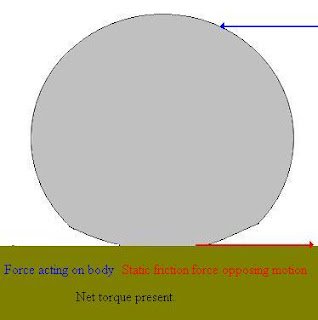Force acting b/w center and the lowest point.
The case is as shown below.

As in Case 1. Forces will be acting as shown.
But all will tend it to rotate to the left.
CASE 2. A
Magnitude of force below rolling friction force.
Body wont move.
CASE 2. B
Magnitude of force equal to the rolling friction force.
Body will start rolling.
Static friction will act in the body from ground will try to avoid the body from slipping relative to ground.
CASE 3.
Force acting at any point centre, or above ground.
The situation will be the same…
Now What is the difference when it acts a higher point and at a lower point??
From our experience we know that, the higher point the force acts the easier it to move.
Why??
The higher the point act greater will be the torque acting. Greater will be force by the Static friction force. Resulting in higher acceleration.
Now if the force is much greater value, the body will start slipping – the torque/ radius of the body will be greater than the maximum static friction that can be provided, and it starts slipping.
This is explained in Traction section.
CASE 3. AThe ground is rigid and the body is soft allowing deformation.
The body will have a tendency for rolling. The case is as shown below

No comments:
Post a Comment